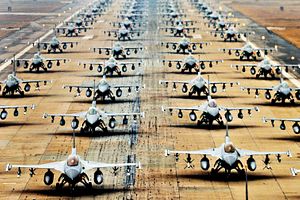It is only a matter of time before North Korea flaunts its ability to miniaturize a nuclear warhead, deploy intercontinental ballistic missiles and road-mobile missile launchers, and expand its plutonium nuclear arsenal with highly enriched uranium warheads. The cumulative failure of diplomacy to rein in Pyongyang’s nuclear and missile programs begs the question as to whether it is time to turn the tables on North Korea. Rather than buy into a losing competitive strategy, hasn’t the time come for the United States and the Republic of Korea (ROK), with the support of others, to pursue a strategy of active defense that alters the North’s cost-benefit calculus?
The North Korean threat is inherently volatile and far more dangerous in the near-term than the sea skirmishes in the East and South China Seas. Because the North threatens to escalate, however, democracies are reluctant to accept risk. Former Secretary of Defense William Perry backed off possible strikes on Yongbyon reactor in 1994 because, as he put it, he was seeking to avert a general war rather than to cause it.
Without throwing caution to the wind, the U.S.-ROK alliance needs to introduce more risk into its approach. Our risk aversion grants North Korea wide latitude for mischief. Pyongyang uses an array of asymmetrical means—from unmanned aerial vehicles (UAVs) and cyber warfare to mini submarines and nuclear weapons–to poke holes through the superior conventional capabilities of the U.S.-ROK alliance. This is because the main purpose of the North’s asymmetric threats is not to use these weapons but to coerce benefits by threatening to use them.
The United States and the Republic of Korea have responded to the growing uncertainty surrounding the Kim Family Regime under the young Kim Jong-Un. They have doubled down on readiness, counter-provocation plans, exercises, deployments and missile defenses. These are important and welcome steps. But at some point the alliance needs to understand the math: North Korea is capable of posing more asymmetrical threats than the alliance can afford to counter with 100 percent effectiveness. Instead of trying to counter each specific threat, Seoul and Washington need to balance deterrence by denial with deterrence by punishment.
Such an active defense strategy has at least three essential defense components. The first is an upgraded intelligence, surveillance and reconnaissance (ISR) network, capable of early detection of ballistic missiles, as well as low-altitude cruise missiles and UAVs. The second is an upgraded missile defense system that includes deployment of better point defense systems (PAC-III) and wider-range defenses that include not only Standard Missiles on Aegis-equipped destroyers but also land-based Terminal High-Altitude Area Defense (THAAD) batteries. Third, there must be a stronger offensive capability, one that poses a “kill chain” threat capable of preempting missile launches before they happen. The aim is not to actually preempt but rather to pose the threat of preemption, thereby forcing North Korea to be more circumspect before threatening to turn South Korea into a sea of fire with every whim.
One way to threaten preemption even without missiles is to further develop a non-nuclear electromagnetic pulse (EMP) weapon that could neutralize missiles on the launcher. Because North Korea will soon develop road-mobile missiles capable of firing nuclear weapons, the further development of non-nuclear EMP systems capable of taking out, say, a 50-square-kilometer joint fire area, would also shift the cost-benefit calculus against North Korea.
Let’s also consider the recent North Korean deployment of three UAVs into South Korea. It boggles the mind to imagine how much leverage North Korea appeared to gain in South Korea by deploying what amounted to toy drones that pose no direct threat to the country. After all, the United States and South Korea have two huge advantages over the North: they are both open democracies with advanced technology. North Korea, on the other hand, is a closed society fearful of information, which forces it to smuggle in whatever technology it can buy through clandestine channels and the black market.
In addition to direct defense investments, the UAV incident suggests that the alliance should be making far greater use of its information advantage. While North and South Korea agreed some years ago to forego psychological warfare against each other, the North is a flagrant purveyor of vitriol and falsehood. Surely the alliance can better saturate the North with uncomfortable facts—from pictures of Kim Jong-Un’s luxury houses side by side with North Korean gulags, to video lectures by North Korean refugees who have managed to escape the world’s most oppressive regime.
The bottom line is this: in addition to shoring up deterrence with more defense, the alliance can gain greater leverage against North Korean brinkmanship and coercion by adding an element of active defense and information warfare. It’s time to make North Korea have to worry more about deterring us rather than the other way around.
Dr. Patrick M. Cronin is senior advisor and senior director of the Asia-Pacific Security Program at the Center for a New American Security in Washington, DC. He is the author of If Deterrence Fails: Rethinking Conflict on the Korean Peninsula (Center for a New American Security: 2014).

































